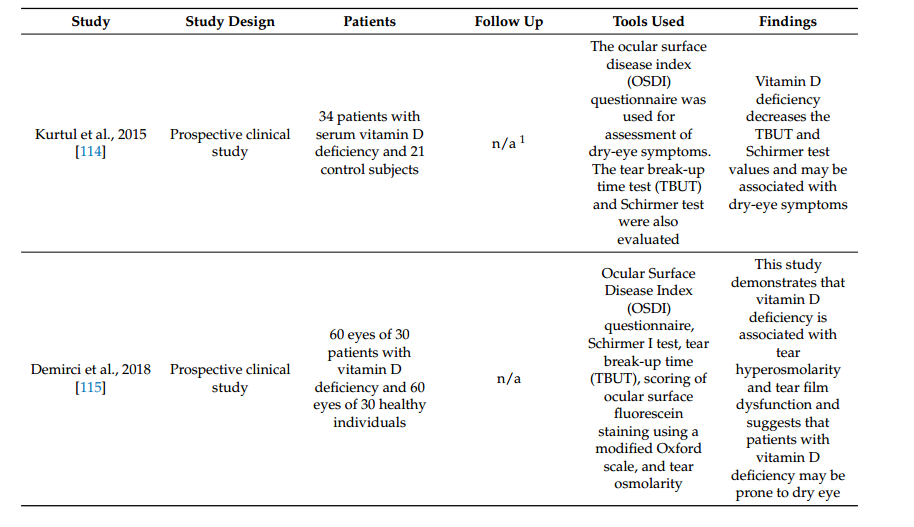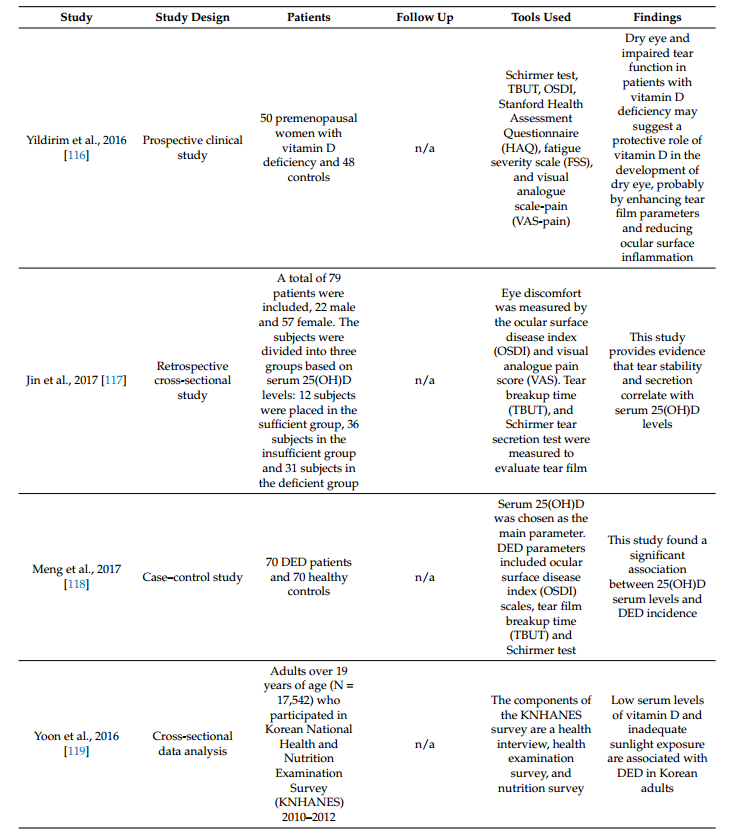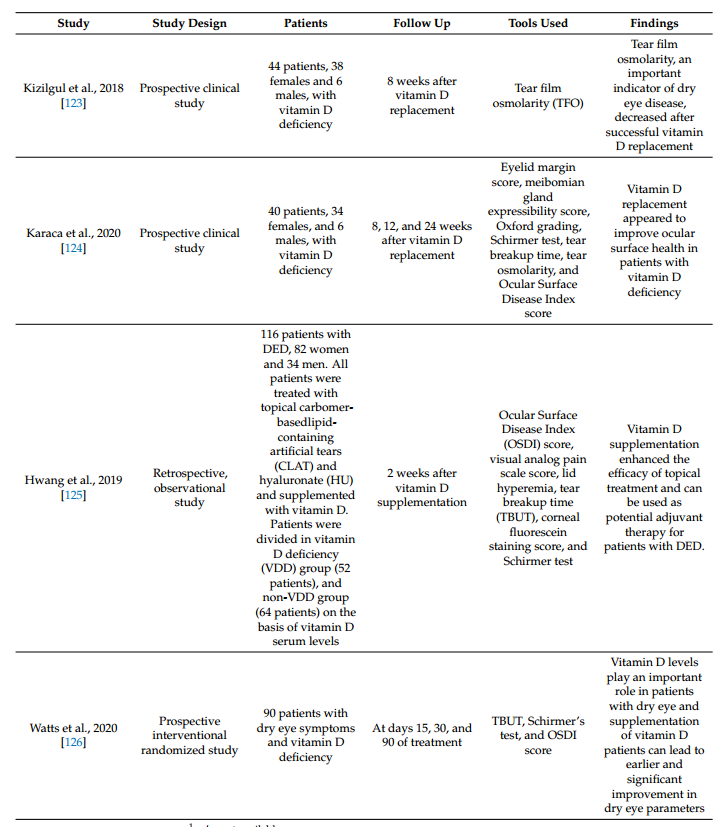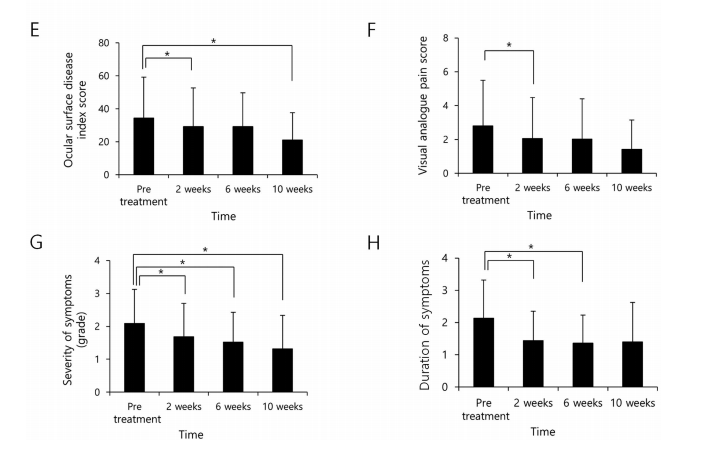Vitamin D and dry eye: a potential new avenue for treatment
Time: Nov 05,2024
Introduction
Dry Eye Disease (DED) is a multifactorial chronic disease characterized by a range of symptoms caused by tear film instability, which may be accompanied by ocular surface damage. In response to tear film instability, clinical treatments for dry eye generally take two routes: preventing the corneal surface from drying out, and suppressing the inflammatory response of the eye. Recently there has been a growing number of clinical trials that have identified vitamin D as a possible new avenue for the treatment of dry eye.
The role of vitamin D in the eye
Vitamin D refers to a group of fat-soluble steroids that are produced by irradiating the skin with ultraviolet rays from sunlight and can also be obtained from food. Vitamin D is involved in several processes that regulate the immune-inflammatory response, for example, 1,25-dihydroxyvitamin D (the activated form of vitamin D) inhibits cell proliferation and stimulates differentiation. A large body of scientific evidence suggests that 1,25-dihydroxyvitamin D enhances innate immunity and inhibits the development of autoimmunity, and conversely the immune system may be impaired if vitamin D is deficient.
Numerous preclinical studies have identified the presence of vitamin D receptors (VDRs) and enzymes required for vitamin D metabolism in many cells within the eye, suggesting that vitamin D is a paracrine/autocrine regulator, and experimental evidence suggests that retinal and corneal cells convert vitamin D to an active form and are capable of synthesizing vitamin D from exogenous 7-dehydrocholesterol following UV exposure.
Several ocular diseases, including uveitis, retinoblastoma, diabetic retinopathy, age-related macular degeneration, myopia, and dry eye, have been associated with vitamin D deficiency and genetic variants that regulate its metabolism.
The association between vitamin D and dry eye
Studies have shown that vitamin D has anti-inflammatory properties that inhibit the production of inflammatory cytokines such as interleukins and tumor necrosis factor (TNF-α), thereby reducing the inflammatory response. The hyperosmolar state of tears and inflammation of the ocular surface, which are common in patients with dry eye, are important mechanisms in the development and progression of the disease. Therefore, the anti-inflammatory effects of vitamin D may help alleviate dry eye.
Several clinical studies have examined the relationship between vitamin D deficiency and dry eye. The data show that people with lower vitamin D levels are more likely to experience dry eye symptoms such as inadequate tear production and tear film instability. A case-control study of 70 dry eye patients and 70 healthy controls showed that dry eye patients had significantly lower serum vitamin D levels than the healthy population. In addition, another study found that vitamin D supplementation increased tear production, improved tear quality, and alleviated the inflammatory response on the ocular surface.
These studies suggest that vitamin D insufficiency may be a risk factor for the development and exacerbation of dry eye and that vitamin D supplementation may be a potential treatment for patients with dry eye.
Below are some of the clinical studies on vitamin D for dry eye:
Table 1 Literature studies on vitamin D for dry eye



Vitamin D Supplementation and Dry Eye Treatment
Whether ingested from food or through supplements (e.g., cholecalciferol and ergocalciferol), vitamin D is rapidly absorbed in the small intestine, with peak plasma vitamin D levels reached within 24 hours. Of these, cholecalciferol (vitamin D3) maintains serum 25(OH)D (the main storage form of vitamin D in the body) concentrations for a longer period of time than ergocalciferol (vitamin D2). Also, the intake of fatty foods promotes the absorption of vitamin D. This means that a proper dietary regimen can improve vitamin D utilization.
Although research on vitamin D in the treatment of dry eye is still in its early stages, there have been clinical studies showing that vitamin D-deficient dry eye patients not only experienced increased tear production and improved tear film quality, but also significant improvements in ocular surface inflammation through systematic vitamin D supplementation. Notably, vitamin D supplementation also enhanced the effectiveness of topical treatments (e.g., lipid-containing artificial tears).

Figure 1 Effect of vitamin D supplementation on dry eye syndrome

Figure 2 Osteotriol (vitamin D analog) inhibits dry eye-related inflammation
Conclusion
Vitamin D is not only important for the bone and immune system, but also shows potential application in the treatment of dry eye. With more research, vitamin D supplementation may become a new direction in the treatment of dry eye, especially for those patients for whom traditional treatments have not been effective, and vitamin D may offer a completely new therapeutic avenue.
Reference:
[1] Rolando M, Barabino S. Dry eye disease: what is the role of vitamin D?[J]. International Journal of Molecular Sciences, 2023, 24(2): 1458.
[2] Bae S H, Shin Y J, Kim H K, et al. Vitamin D supplementation for patients with dry eye syndrome refractory to conventional treatment[J]. Scientific reports, 2016, 6(1): 33083.
[3] Zhang J, Dai Y, Wu D, et al. Calcitriol, the active metabolite of vitamin D3, inhibits dry eye related corneal inflammation in vivo and in vitro[J]. Ocular Immunology and Inflammation, 2019, 27(2): 257-265.
Related News


